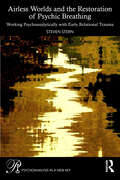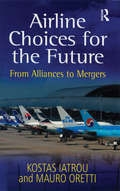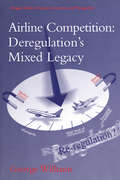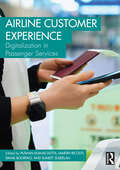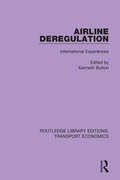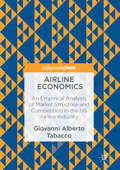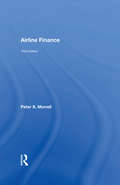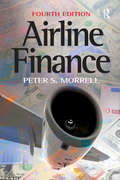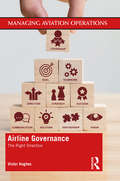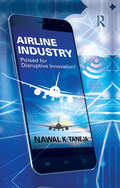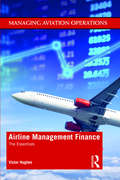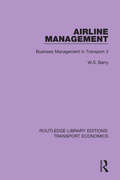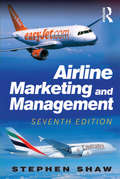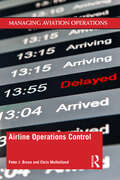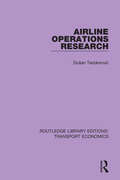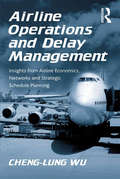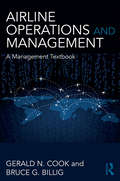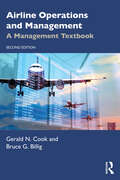- Table View
- List View
Airless Worlds and the Restoration of Psychic Breathing: Working Psychoanalytically with Early Relational Trauma (Psychoanalysis in a New Key Book Series)
by Steven SternThis book focuses on the recognition and psychoanalytic treatment of a debilitating form of early relational trauma poignantly described by Steven Stern as airless world syndrome. A patient can be said to be living in an airless world when one or both parents have failed to recognize, or worse, actively negated their child’s subjective experience and needs, instead imposing their subjective reality on the child such that the child had no choice but to adopt the parents’ reality as their own. When a child’s mind is captured in this way—what Stern calls identification with negation—the result is an unconscious bondage to the internalized negating other which can be disabling to the senses of self, personal agency, and realness. With extended clinical examples in every chapter, Stern brings the reader into the depths of each patient’s airless world and the co-created needed relationship that ultimately, fitfully transforms it.Written in a detailed yet accessible style, this book is invaluable to psychoanalysts and psychotherapists in practice and in training.
Airline Business in the 21st Century
by Rigas DoganisThis book focuses on the major issues that will affect the airline industry in this new millennium. It tells of an industry working on low margins and of cut-throat competition resulting from 'open skies'. Among the issues discussed are:* the low-cost airline* the impact of electronic commerce* the debate on global airline alliances* privatizing state-owned airlines* the creation of a Trans Atlantic Common Aviation areaMost importantly, the book carefully analyzes the strategies that are needed for airlines to succeed in the twenty-first century. This is essential reading for anyone interested in aviation.
Airline Choices for the Future: From Alliances to Mergers
by Kostas Iatrou Mauro OrettiAirline Choices for the Future: From Alliances to Mergers offers an up-to-date assessment of the industry as it stands today, delivering a comprehensive insight into how the world of airline alliances is changing, and how the merger phenomenon is likely to fit into the new scenario. The purpose of this book is twofold. Firstly, it outlines the evolution and the reasons behind alliances between international air carriers, the alliances' track records and the way they have affected airlines and the air transport industry. Secondly, drawing on past and more recent developments in the industry, it examines the experiences airlines involved in cross-border mergers have gone through and the advantages and difficulties they have come across. Alliances and mergers are presented from both the airline and the consumer perspective. The book provides a balanced account of where mergers and alliances have taken the industry to date, bridging the gap between merger theory and implemented practices and strategies. It also identifies the challenges alliances and cross-border mergers have faced and highlights the key forces affecting airline development. Theoretical evidence is supplemented by data collected via surveys and interviews with airline executives, aviation experts, consultants and regulatory bodies.
Airline Competition: Deregulation's Mixed Legacy (Ashgate Studies in Aviation Economics and Management)
by George WilliamsThe advantages of airline competition to consumers are clearly apparent. Lower fares, greater choice, more frequent flights and a wider range of available services have all been evident when the entry of a new competitor has occurred. In many instances however, after an initial, relatively short-lived, period of aggressive competition the new entrant has either gone bankrupt or found a less stressful existence co-operating in some manner with the incumbent. In this wide-ranging book, the author looks at the competitive arena in the post-regulation era and especially focusses on deregulation’s legacy; globalization in a bilateral world breaking the link between nationality and airlines. The book is of special interest to those members engaged in the Airline Industry, Regulatory Authorities and Government Departments of Transport and Industry. It will be of value to academic specialists in transport economics and public policy; MSc students and Institutes of Transport; pressure groups and the Travel and Tourism Industry.
Airline Customer Experience: Digitalization in Passenger Services
by Pushan Kumar Dutta Ismail Bogrekci Martin Ricciuti Sumeet SuseelanIn the 21st century, commercial aviation has been transformed into a passenger-centric business in which the customer has assumed an ever more active role in managing their own journeys. This trend is set to continue with innovations and transformations in multiple areas. Point-of-sale solutions will redefine in-flight commerce, making it easier for passengers to make purchases during their journey. Telemedicine will ensure health and safety onboard, allowing for immediate medical assistance in case of emergencies. The shift to personal electronic devices for in-flight entertainment (IFE) will cater to the digitally savvy passenger and their expectations in the digital age. Smart cabins will revolutionize in-flight food and beverage services, providing passengers with a more personalized and enjoyable experience. Data-driven catering will reduce food waste and boost profits in aviation. In short, all areas of the passenger experience will be affected by ongoing digital transformation.Airline Customer Experience: Digitalization in Passenger Services aims to show how digitalization is transforming the way the aviation industry operates, making it more efficient, profitable, and sustainable. The wide-ranging contents embrace all aspects of aviation relating to the customer experience, from purchase and pre-check-in, to the services offered to passengers in flight and beyond. The authors present a nuanced and kaleidoscopic view of the airline customer experience, which will be at once familiar and illuminating to readers.This book is an essential resource for advanced postgraduate students and researchers working in aviation, particularly those with a focus on aviation service operations management, customer services, and customer relationship management. Practicing airline managers and operators will also value the innovative insights and examples the book offers.
Airline Deregulation: International Experiences (Routledge Library Editions: Transport Economics #1)
by Kenneth ButtonThe end of the twentieth century saw remarkable changes in the way that economic regulation was viewed. There occurred a liberalization of attitude and something of a withdrawal of the state from its interventionist role. These changes were particularly pronounced in the context of transport, where the long-standing tradition had been one of market intervention by the government. The aim of this book, first published in 1991, is to examine the outcomes of deregulation on the international airline industry, and to consider whether the experiences of market liberalization reveal any common threads. In particular, whether they reveal any universal indications of how underlying transport markets function; how management responds to new stimuli; the degree of protection needed by transport users; and nature of the transition process from regulation to liberalization.
Airline Economics: An Empirical Analysis of Market Structure and Competition in the US Airline Industry
by Giovanni Alberto TabaccoThis book presents an original empirical investigation of the market structure of airline city pair markets, shedding new light on the workings of competitive processes between firms. Examining a cross-section of US airline city pairs, Tabacco proposes for the first time that the industry can be understood as a natural oligopoly, each airline market being dominated by one to three airline carriers regardless of market size. The author questions the extent to which airlines deliberately prevent head-to-head competition within city pair markets, and draws intriguing conclusions about competitive forces from the observed market structure. Uncovering some of the main corporate strategies of the airline industry, the book is of immediate relevance to industry managers and practitioners, as well as academic economists.
Airline Finance
by Peter S. MorrellAir transport industry finance, with its complexity and special needs such as route rights, airport slots, aircraft leasing options and frequent flyer programmes, requires specific knowledge. While there are numerous financial management and corporate finance texts available, few of these provide explanations for the singularities of the airline industry with worked examples drawn directly from the industry itself. Revised and updated in its third edition, this internationally renowned and respected book provides the essentials to understanding all areas of airline finance. Designed to address each of the distinct areas of financial management in an air transport industry context, it also shows how these fit together, while each chapter and topic provides a detailed resource which can be also consulted separately. Supported at each stage by practical airline examples, it examines the financial trends and prospects for the airline industry as a whole, contrasting the developments for the major regions and airlines. Important techniques in financial analysis are applied to the airline industry, together with critical discussion of key issues. Thoroughly amended and updated throughout, the third edition reflects the many developments that have affected the industry since 2001. It features several important new topics, including Low Cost Carriers (LCCs), fuel hedging and US Chapter 11 provisions. The sections on financial statements and privatisation have been expanded, and a new chapter has been added on equity finance and IPOs. New case studies have been added, as well as the latest available financial data. The range and perspective is even greater than before, with significant expansion of material specific to the US and Asia. The book is a key resource for students of airline management, and a sophisticated and authoritative guide for analysts in financial institutions and consultancies, executives in airlines and related industries, and civil aviation departments.
Airline Finance
by Peter S. MorrellRevised and updated in its fifth edition, this internationally renowned and respected book provides the essentials to understanding all areas of airline finance. Designed to address each of the distinct areas of financial management in an air transport industry context, it also shows how these fit together, while each chapter and topic – for example, aircraft leasing – provides a detailed resource that can also be consulted separately. Supported at each stage by practical airline examples and recent data, Airline Finance examines the financial trends and longer term prospects for the airline industry as a whole, contrasting the developments for the major regions and airlines together with critical discussion of key issues that affect the industry as a whole. Important techniques in financial analysis are applied to the airlines as well as their investors such as banks and other financial institutions. Thoroughly amended and updated throughout, and expanded with the addition of two new chapters, the fifth edition reflects the many developments that have affected the industry, such as the impacts of the banking and sovereign debt crises on the airline industry, signs of re-nationalisation of airlines that have emerged in Europe, and the substantial changes that have occurred in connection with rating agencies and LIBOR. New start-ups and bankruptcies are covered for the first time in a new chapter, joined by airline mergers and acquisitions (M&A), both playing a role in airline concentration. Reflecting their status as a permanent feature, fuel hedging and fuel surcharges now also have their own chapter. The medium- to long-term future in terms of further concentration and government intervention (or the lack of it) and a shift in aircraft financing towards capital markets are discussed in the final chapter. The book is written for employees of airlines, airports and their suppliers, and investment bank and other analysts. It is also popular for use by universities and in-house courses on air transport management, within both academia and industry.
Airline Finance (Routledge Revivals Ser.)
by Peter S. MorrellAir transport industry finance, with its complexity and special needs such as route rights, airport slots, aircraft leasing options and frequent flyer programmes, requires specific knowledge. While there are numerous financial management and corporate finance texts available, few of these provide explanations for the singularities of the airline industry with worked examples drawn directly from the industry itself. Revised and updated in its fourth edition, this internationally renowned and respected book provides the essentials to understanding all areas of airline finance. Designed to address each of the distinct areas of financial management in an air transport industry context, it also shows how these fit together, while each chapter and topic provides a detailed resource which can be also consulted separately. Supported at each stage by practical airline examples, it examines the financial trends and prospects for the airline industry as a whole, contrasting the developments for the major regions and airlines. Important techniques in financial analysis are applied to the airline industry, together with critical discussion of key issues. Thoroughly amended and updated throughout, the fourth edition reflects the many developments that have affected the industry, with a particular emphasis on the full impact of the global banking and sovereign debt crises. This edition also features new material discussing the increased airline mergers and acquisitions (M&A) activity of recent years, and considers the likelihood of further consolidation in the future. The book is a key resource for students of airline management, and a sophisticated and authoritative guide for analysts in financial institutions and consultancies, executives in airlines and related industries, and civil aviation departments.
Airline Finance (Routledge Revivals)
by Peter S MorrellThis title was first published in 2002: The purpose of this book is to provide, as far as possible, a broad understanding of all areas of airline finance. It is intended to be suitable for both those in the industry without any financial background and newcomers to the industry who may have some knowledge of finance.
Airline Governance: The Right Direction (Managing Aviation Operations)
by Victor HughesAnyone becoming a company director faces a steep learning curve; this book will give every director and especially one joining the board of an airline, a head-start on the process.Airline Governance: The Right Direction will help existing directors, those who have been newly appointed and those ‘in waiting’ in a company’s management. This book reviews the fundamentals of corporate governance and puts them into the context of guiding, directing and managing an airline, and also complements the discussion of accounting and finance in its sister book Airline Management Finance: The Essentials. The detailed review will give directors confidence to make decisions on governance matters, avoiding a ‘tick the box’ approach and focusing on what is important. This book not only gives directors a comprehensive introduction to good governance, but also discusses the application of the principles of governance for an airline at various stages of its development so any changes can be made at the right time.Understanding corporate governance not only helps directors, but also an airline’s senior and junior management, because the considerations around matters such as ‘conflict of interest’ apply to all decision-makers in the organisation. Understanding and applying good governance does not guarantee success, but it surely helps in achieving it.
Airline Industry: Poised for Disruptive Innovation?
by Nawal K. TanejaMany business sectors have been, and are being, forced to compete with new competitors-disrupters of some sort-who have found new ways to create and deliver new value for customers often through the use of technology that is coupled with a new underlying production or business model, and/or a broad array of partners, including, in some cases, customers themselves. Think about the disruption created by Apple by the introduction of the iPod and iTunes, and by Netflix within the entertainment sectors using partners within the ecosystem; think of Uber that didn’t build an app around the taxi business but rather built a mobility business around the app to improve customer experience. Airline Industry considers whether the airline industry is poised for disruptive innovations from inside or outside of the industry. Although airlines have a long history of continuous improvements and innovation, few of their innovations can be classified as disruptive innovations. The few disruptive innovations that did emerge were facilitated, for example by new technology (jet aircraft) and government policy (deregulation). Now there are new forces in play-customers who expect to receive products that are more personalized and experience-based throughout the entire journey, new customer interfaces (via social media), advanced information systems and analytics, financially powerful airlines based in emerging nations, and the rise of unencumbered entrepreneurs who think differently as well as platform-focused integrators.
Airline Management Finance: The Essentials (Managing Aviation Operations)
by Victor HughesAirline Management Finance: The Essentials is of significant benefit to airline industry practitioners seeking a focused, neatly contained and accessible resource that provides explicit financial information pertinent to their current or future role. The book explains and demystifies an airline’s financing and the financial reporting of its operations to airline staff and others. It seeks to explain the role of finance and the Finance Department in a non-technical way, so staff can appreciate the value of the department and its information resources, and see finance as an active contributor to the airline’s operation. It concentrates on practical matters, explaining frequently used financial and accounting terms, how financial strategy works, the uses of various types of financial reporting, as well as what financial risk is and how it can be managed through the co-operation of finance and operating staff. Staff who understand the airline’s finances and financial system are more likely to make decisions which align with the airline’s strategy and objectives. They will also know how to use the financial information which is available. The book establishes a good foundation of financial knowledge for all staff. This book is recommended reading for new employees in airline finance and related areas, as well as those starting to move up the supervisory ladder in an airline.
Airline Management: Business Management in Transport 3 (Routledge Library Editions: Transport Economics #2)
by W.S. BarryThis book, first published in 1965, illustrates the world of management in the airline industry. It examines the external relations with customers, government, investors, suppliers and competitors, as well as internal relations within the business such as organization and industrial relations.
Airline Marketing and Management
by Stephen ShawThrough six previous editions, Airline Marketing and Management has established itself as the leading textbook for students of marketing and its application to today's airline industry, as well as a reference work for those with a professional interest in the area. Carefully revised, the seventh edition of this internationally successful book examines an exceptionally turbulent period for the industry. It features new material on: *Changes in customer needs, particularly regarding more business travellers choosing - or being forced - to travel economy, and analysis of the bankruptcy of 'All Business Class' airlines. * An explanation of the US/EU 'Open Skies' agreement and analysis of its impact. *The increase in alliance activity and completion of several recent mergers, and the marketing advantages and disadvantages that have resulted. * Product adjustments that airlines must make to adapt to changes in the marketing environment, such as schedule re-adjustments and the reconfiguration of aircraft cabins. *Changes in pricing philosophies, with, for example, airlines moving to 'A La Carte' pricing, whereby baggage, catering and priority boarding are paid for as extras. *Airline websites and their role as both a selling and distributing tool. *The future of airline marketing. A review of the structure of the air transport market and the marketing environment is followed by detailed chapters examining business and marketing strategies, product design and management, pricing and revenue management, current and future distribution channels, and selling, advertising and promotional policies. The reader will benefit from greater understanding of both marketing and airline industry jargon and from knowledge obtained regarding the extraordinary strategic challenges now facing aviation. Written in a straightforward, easy-to-read style and combining up-to-date and relevant examples drawn from the worldwide aviation industry, this new edition will further enhance the book's reputation for providing the ideal introduction to the subject.
Airline Marketing and Management
by Stephen ShawThrough six previous editions, Airline Marketing and Management has established itself as the leading textbook for students of marketing and its application to today's airline industry, as well as a reference work for those with a professional interest in the area. Carefully revised, the seventh edition of this internationally successful book examines an exceptionally turbulent period for the industry. It features new material on: *Changes in customer needs, particularly regarding more business travellers choosing - or being forced - to travel economy, and analysis of the bankruptcy of 'All Business Class' airlines. * An explanation of the US/EU 'Open Skies' agreement and analysis of its impact. *The increase in alliance activity and completion of several recent mergers, and the marketing advantages and disadvantages that have resulted. * Product adjustments that airlines must make to adapt to changes in the marketing environment, such as schedule re-adjustments and the reconfiguration of aircraft cabins. *Changes in pricing philosophies, with, for example, airlines moving to 'A La Carte' pricing, whereby baggage, catering and priority boarding are paid for as extras. *Airline websites and their role as both a selling and distributing tool. *The future of airline marketing. A review of the structure of the air transport market and the marketing environment is followed by detailed chapters examining business and marketing strategies, product design and management, pricing and revenue management, current and future distribution channels, and selling, advertising and promotional policies. The reader will benefit from greater understanding of both marketing and airline industry jargon and from knowledge obtained regarding the extraordinary strategic challenges now facing aviation. Written in a straightforward, easy-to-read style and combining up-to-date and relevant examples drawn from the worldwide aviation industry, this new edition will further enhance the book's reputation for providing the ideal introduction to the subject.
Airline Marketing and Management
by Stephen ShawThrough six previous editions, Airline Marketing and Management has established itself as the leading textbook for students of marketing and its application to today's airline industry, as well as a reference work for those with a professional interest in the area. Carefully revised, the seventh edition of this internationally successful book examines an exceptionally turbulent period for the industry. It features new material on: *Changes in customer needs, particularly regarding more business travellers choosing - or being forced - to travel economy, and analysis of the bankruptcy of 'All Business Class' airlines. * An explanation of the US/EU 'Open Skies' agreement and analysis of its impact. *The increase in alliance activity and completion of several recent mergers, and the marketing advantages and disadvantages that have resulted. * Product adjustments that airlines must make to adapt to changes in the marketing environment, such as schedule re-adjustments and the reconfiguration of aircraft cabins. *Changes in pricing philosophies, with, for example, airlines moving to 'A La Carte' pricing, whereby baggage, catering and priority boarding are paid for as extras. *Airline websites and their role as both a selling and distributing tool. *The future of airline marketing. A review of the structure of the air transport market and the marketing environment is followed by detailed chapters examining business and marketing strategies, product design and management, pricing and revenue management, current and future distribution channels, and selling, advertising and promotional policies. The reader will benefit from greater understanding of both marketing and airline industry jargon and from knowledge obtained regarding the extraordinary strategic challenges now facing aviation. Written in a straightforward, easy-to-read style and combining up-to-date and relevant examples drawn from the worldwide aviation industry, this new edition will further enhance the book's reputation for providing the ideal introduction to the subject.
Airline Network Development in Europe and its Implications for Airport Planning
by Guillaume BurghouwtThe ongoing deregulation and liberalization of worldwide air transport markets confronts airport planners with an increasingly problematic context. On the one hand, the capital intensive, large-scale and complex airport investments need a detailed, long/medium-term planning of airport infrastructure. Such planning requires at least predictable traffic volumes (and traffic composition) within the planning horizon. On the other hand, airline route networks are increasingly dynamic structures that frequently show discontinuous changes. As a consequence, the much more volatile airport traffic restricts the value of detailed traffic forecasts. Volatility of airport traffic and its composition requires flexibility of airport strategies and planning processes. The book explores this dilemma through a detailed study of airline network development, airport connectivity and airport planning in the deregulated EU air transport market. The questions the book seeks to answer are: · how have airlines responded to the regime changes in EU aviation with respect to the configuration of their route networks? · what has been the impact of the reconfiguration of airline network configurations for the connectivity of EU airports? · how can airport planners and airport authorities deal with the increasingly uncertain airline network behaviour in Europe?
Airline Network Planning and Scheduling (Wiley Series in Operations Research and Management Science)
by Ahmed Abdelghany Khaled AbdelghanyA concise resource to the best practices and problem-solving ideas for understanding the airline network planning and scheduling process Airline Network Planning and Scheduling offers a comprehensive resource that is filled with the industry's best practices that can help to inform decision-modeling and the problem-solving process. Written by two industry experts, the book is designed to be an accessible guide that contains information for addressing complex challenges, problems, and approaches that arise on the job. The chapters begin by addressing the complex topics at a broad, conceptual level before moving on to more detailed modeling in later chapters. This approach follows the standard airline planning process and reflects the duties of the day-to-day job of network/schedule planners. To help gain a practical understanding of the information presented, each chapter includes exercises and data based on real-world case studies. In addition, throughout the book there are graphs and illustrations as well as, information on the most recent advances in airline network and planning research. This important resource: • Takes a practical approach when detailing airline network planning and scheduling practices as opposed to a theoretical perspective • Puts the focus on the complexity and main challenges as well as current practices and approaches to problem-solving and decision-making • Presents the information in a logical sequence that begins with broad, conceptual topics and gradually delves into more advanced topics that address modeling • Contains international standard airline planning processes, the day-to-day responsibilities of the job, and outlines the steps taken when building an airline network and schedule • Includes numerous case studies, exercises, graphs, and illustrations throughout Written for professionals and academics, Airline Network Planning and Scheduling offers a resource for understanding best practices and models as well as the challenges involved with network planning and scheduling.
Airline Operations Control (Managing Aviation Operations)
by Peter J. Bruce Chris MulhollandThis text is among the first to reveal the intricacies of an airline’s Operations Control Centre; especially the thought processes, information flows, and strategies taken to mitigate disruptions. Airline Operations Control provides a deep level of description, explanation and detail into the activities of a range of highly professional and expert staff managing the ‘sharp’ end of the airline. It aims to fill a void as little is understood about this area, and very little is written for practitioners in the airline business. The book offers a comprehensive look at the make-up of the Operations Centre, its component sections, and the processes that occur both in preparing for and executing the current day’s schedules. Several chapters provide real-life scenarios and demonstrate how Operations Centres manage evolving situations – what they need to take into account, and how they need to have Plan B and Plan C ready when things don’t go right. This book is designed to deliver knowledge gains to both new and experienced aviation industry practitioners with regards to vital operational aspects. Additionally, it also offers students of air transport management a readily accessible and real-world-perspective guide to a crucial function present within every airline.
Airline Operations Research (Routledge Library Editions: Transport Economics #3)
by Dusan TeodorovicThe increase in practical problems generated by the intensive growth in air transport has necessitated the development of specialised operations research methods and modern computer technology. By combining operational research data from both scientific publications and airline companies, this book, first published in 1988, provides a unique source of information for those working on the development and application of operations research analysis in air transportation. Topics include air transport analysis, flight frequency determination, the scheduling of flights and personnel, and the problems of airline overbooking.
Airline Operations and Delay Management: Insights from Airline Economics, Networks and Strategic Schedule Planning
by Cheng-Lung WuAirline Operations and Delay Management fills a gap within the area of airline schedule planning by addressing the close relationships between network development, economic driving forces, schedule demands and operational complexity. The pursuit of robust airline scheduling and reliable airline operations is discussed in light of the future trends of airline scheduling and technology applications in airline operations. The book extensively explores the subject from the perspectives of airline economics, airline network development and airline scheduling practices. Many operational issues and problems are the inevitable consequences of airline network development and scheduling philosophy, so a wide perspective is essential to address airline operations in their proper context. The influence of airline network development on schedule planning and operations driven by economic forces and relaxed regulations is thoroughly examined for different types of operations in aviation such as network carriers and low-cost carriers. The advantages and disadvantages of running different networks and schedules are discussed and illustrated with real airline examples. In addition, this book provides readers with various mathematical models for solving different issues in airline operations and delay management. Airline Operations and Delay Management is ideal for senior undergraduate students as an introductory book on airline operations. The more advanced materials included in this book regarding modeling airline operations are suitable for postgraduate students, advanced readers and professionals interested in modeling and solving airline operational problems.
Airline Operations and Management: A Management Textbook
by Bruce Billig Gerald N. CookAirline Operations and Management: A Management Textbook is a survey of the airline industry, mostly from a managerial perspective. It integrates and applies the fundamentals of several management disciplines, particularly economics, operations, marketing and finance, in developing the overview of the industry. The focus is on tactical, rather than strategic, management that is specialized or unique to the airline industry. The primary audiences for this textbook are both senior and graduate students of airline management, but it should also be useful to entry and junior level airline managers and professionals seeking to expand their knowledge of the industry beyond their own functional area.
Airline Operations and Management: A Management Textbook
by Bruce Billig Gerald N. CookAirline Operations and Management: A Management Textbook presents a survey of the airline industry, with a strong managerial perspective. It integrates and applies the fundamentals of several management disciplines, particularly operations, marketing, economics and finance, to develop a comprehensive overview. It also provides readers with a solid historical background, and offers a global perspective of the industry, with examples drawn from airlines around the world. Updates for the second edition include: • Fresh data and examples • A range of international case studies exploring real-life applications. • New or increased coverage of key topics such as the COVID-19 pandemic, state aid, and new business models. • New chapters on fleet management and labor relations and HRM. • Lecture slides for instructors. This textbook is for advanced undergraduate and graduate students of airline management, but it should also be useful to entry and junior-level airline managers and professionals seeking to expand their knowledge of the industry beyond their functional area.
